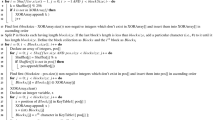Abstract
A new Shamir’s three pass random matrix ciphering mechanism. This new random matrix ciphering mechanism uses a three-pass protocol with encryption operators that are random commutative matrices. The three-pass protocol, at the same time, allows the authentication of the participants in the transaction (Alice and Bob as usual). The novelty of this mechanism is that it uses two encryption matrices for Alice [AC1] and [AC2] and for Bob [BC1] and [BC2], which "encapsulate" the message matrix [M]. For example, the data flow from Bob to Alice is the product of five matrices: [BC1][AC1][M][AC2][BC2] in which the possibility for Alice to delete her encryption matrices [AC1] and [AC2], implies that the matrices: [BC1] and [AC1] and also [AC2] and [BC2] be commutative, therefore randomly generated in the same eigenvector spaces. This is made possible because a non-singular matrix [G] can be put in the following form: [G] = [C] [D] [C]-1 in which the matrix [C] is related to the eigenvector space of the matrix [G], the diagonal matrix [D] being its eigenvalues. This equation then makes it possible to write an infinity of encryption commutative matrices [G] belonging to this eigenvector space, each having different eigenvalues [D] generated randomly by the mechanism. The proposed mechanism is based on this equation. The authentication process consists of a pseudo-random permutation module, embedded in the mechanism, generating permutation matrices which are unique identifiers of Alice and Bob. These permutation matrices also "encapsulate" the data stream exchanged between Alice and Bob.




Similar content being viewed by others
Data availability
Data sharing is not applicable to this article as no datasets were generated or analyzed during the current study.
References
Hasdiana, H., Sembiring, R. W.: Hill Cipher On Shamir's three pass protocol. In: The 3rd international conference on multidisciplinary research (ICMR) 2014 (Medan, Indonesia)
Mezher, L.S., Abbass, A.M.: Mixed Hill Cipher methods with triple pass protocol methods. Int. J. Electr. Comput. Eng. (IJECE) 11(5), 4449ff (2021)
Lang, J.: A no-key-exchange secure image sharing scheme based on Shamir’s three-pass cryptography protocol and the multiple-parameter fractional Fourier transform. Opt. Express 20(3), 2386 (2012)
: General Security Repository National Agency for the Security of Information Systems: https://www.ssi.gouv.fr/
Horn, R. A., and Johnson, C. R.: Matrix Analysis. Cambridge University Press, 2nd edition 2013 section 0.9.5 (1991)
Angot, A.: Compléments de mathématiques; les Editions d’optique, pp. 174 (1961)
Horn, R. A., and Johnson, C. R.: Op cite section 0.9.6 (1991)
Przemieniecki, J.S.: Theory of matrix structural analysis. Mac Graw Hill, pp. 413 (1968)
Funding
No funding was received to assist with the preparation of this manuscript.
Author information
Authors and Affiliations
Corresponding author
Ethics declarations
Conflict of interest
The authors have no competing interests to declare that are relevant to the content of this article.
Additional information
Publisher's Note
Springer Nature remains neutral with regard to jurisdictional claims in published maps and institutional affiliations.
Rights and permissions
Springer Nature or its licensor (e.g. a society or other partner) holds exclusive rights to this article under a publishing agreement with the author(s) or other rightsholder(s); author self-archiving of the accepted manuscript version of this article is solely governed by the terms of such publishing agreement and applicable law.
About this article
Cite this article
Dupont, F. A new Shamir’s three pass random matrix ciphering mechanism. J Comput Virol Hack Tech 20, 237–248 (2024). https://doi.org/10.1007/s11416-023-00467-0
Received:
Accepted:
Published:
Issue Date:
DOI: https://doi.org/10.1007/s11416-023-00467-0




